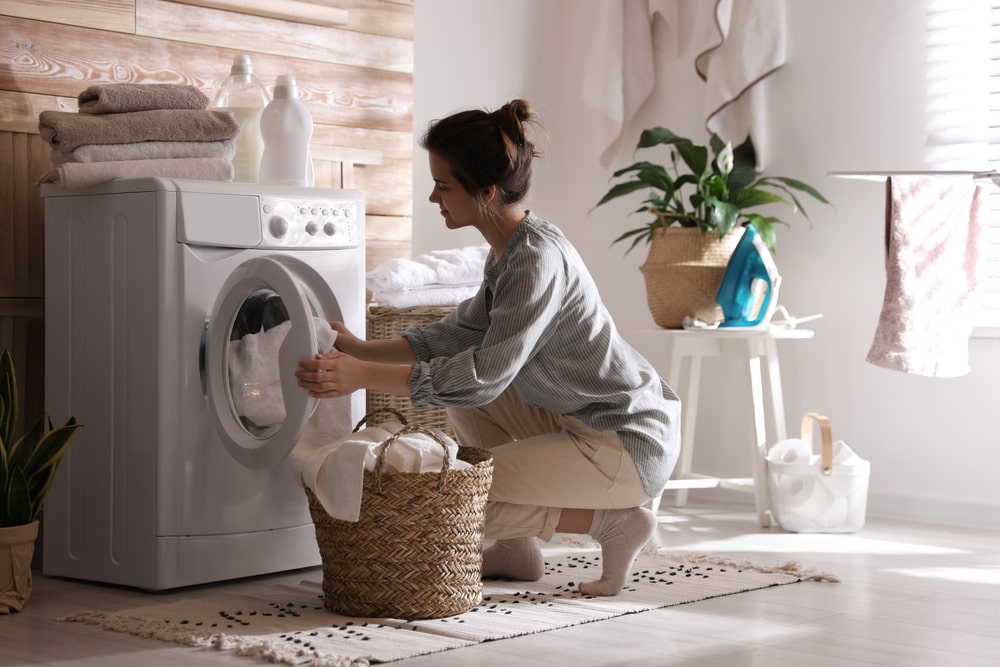Home > Energy Plans > How Much Electricity Does A Dryer Use?
How Much Electricity Does A Dryer Use?
Are you wondering how much electricity your clothes dryer uses? Find out here plus learn energy-saving tips with Savvy.
Author
Savvy Editorial TeamFact checked

Clothes dryers are really convenient when we want to quickly dry our laundry, but have you ever wondered about how much electricity a clothes dryer uses? Understanding how much electricity a clothes dryer uses can provide valuable insights into managing your rising electricity bills.
In this Savvy guide, we explore the average electricity consumption of different types of clothes dryers, including vented, condenser, and heat pump models. Learn about energy-saving features, optimal usage practices, and tips to maximise efficiency while drying your clothes.
How much electricity do different types of clothes dryers use?
Clothes dryers are regarded as essential appliances for efficiently drying our clothes these days. However, it’s worth remembering that they only began to make an appearance in Aussie homes in the middle 1960’s. Before that time clothes were dried exclusively by hanging them out on a line or by the fire.
Dryers are big consumers of electricity. Understanding the electricity usage of different types of clothes dryers can help you make an informed decision about the energy efficiency of different types, and so manage your electricity costs.
Vented clothes dryers:
Vented clothes dryers are the most traditional type, and require an external vent to release hot, moist air. On average, vented dryers consume around 2.4 to 4.8 kilowatt-hours (kWh) of electricity per load. However, power usage can vary depending on factors such as the load size, the fabric type of the clothes you’re drying, and the drying time you set.
Condenser clothes dryers:
Condenser dryers do not require external venting, and instead collect moisture from the drying process in a water container or drain. These dryers generally use slightly more electricity compared to vented dryers, averaging between 2.8 and 5.5 kilowatt-hours (kWh) per load.
Heat pump clothes dryers:
Heat pump dryers are the most energy-efficient option, utilising a heat exchange process to dry clothes. They consume significantly less electricity than vented and condenser dryers. On average, heat pump dryers use around 1.3 to 2.4 kilowatt-hours (kWh) per load, making them the most cost-effective and environmentally friendly choice.
How can I minimise my power usage when drying my clothes?
Here’s some great tips to minimise your power usage when drying your clothes:
- Choose the right dryer: Swap to an energy-efficient clothes dryer that is designed to consume less power. Look for models with high energy star ratings and energy-saving features, like cycle delay switches which allow you to choose when to dry your clothes.
- Dry clothes on a clothesline: Consider air-drying your clothes partially on a clothesline or drying rack before transferring them to the dryer. This reduces the overall drying time and energy use.
- Load capacity: Optimise the load size of your dryer. Overloading or underloading the machine can result in inefficient drying and higher energy Aim for a balanced and appropriately sized load.
- Dry similar fabrics together: Sort your laundry based on fabric type and weight. Drying similar fabrics together ensures more even drying and reduces the need for extended drying cycles.
- Spin-dry clothes before drying: If your washing machine has a spin-dry feature, use it to remove excess water from your clothes before transferring them to the dryer. This step reduces drying time and energy use.
- Clean the lint filter regularly: Keep the lint filter clean to maintain proper airflow. A clogged filter restricts air circulation and forces the dryer to work harder, increasing energy use. Clean the filter after each use or as recommended by the manufacturer.
- Utilise sensor drying: Many modern dryers offer sensor drying technology that detects the moisture level in your clothes and automatically adjusts the drying time accordingly. This feature prevents over-drying and saves money on your energy plan.
- Dry clothes during off-peak hours: If your electricity provider offers off-peak pricing, take advantage of lower rates by running your dryer during those times. This can result in cost savings on your energy
- Maintain proper dryer ventilation: Ensure that the dryer vent and exhaust ducts are clean and unobstructed. Good ventilation helps the dryer operate efficiently and reduces energy
By following these tips, you can minimise your power usage when drying clothes and reduce the environmental impact while still achieving effective drying results.
Which is better - condenser dryers, or heat pump dryers?
Heat pump dryers are an excellent choice for regular use due to their low power consumption. They utilise innovative technology (similar to a fridge), to create and evenly distribute warm air, resulting in energy savings that compensate for the higher initial cost. These dryers also recycle and reheat the same air within the drum, maximising efficiency.
However, if you only dry laundry occasionally, for example once a week, a condenser dryer might be a more suitable option. Price-wise, condenser dryers are approximately half the cost of heat pump dryers, making them a budget-friendly alternative for infrequent drying use.
How do I calculate how much an electrical appliance costs to run?
To calculate how much an appliance costs to run, you can follow these steps:
- Identify the power rating: Find the power rating of the appliance, usually measured in watts (W) or kilowatts (kW). This information is typically mentioned on the appliance itself or in the product documentation.
- Determine the operating time: Estimate the average number of hours the appliance operates per day or week. Consider your typical usage pattern over an average week to get an accurate estimate.
- Convert watts to kilowatts: If the power rating is given in watts, divide it by 1,000 to convert it to kilowatts. For example, if the appliance has a power rating of 1,200 watts, it would be 1.2 kilowatts.
- Calculate energy consumption: Multiply the power rating in kilowatts by the number of hours the appliance operates. For instance, if the appliance uses 1.2 kilowatts and operates for 4 hours per day, the daily energy consumption would be 4.8 kilowatt-hours (kWh).
- Find out your electricity tariff: Check your electricity bill or contact your electricity provider to find the tariff rate you are charged for electricity. This rate is usually measured in cents per kilowatt-hour (c/kWh).
- Calculate the cost: Multiply the daily energy consumption (in kilowatt-hours) by the tariff rate (in cents/kWh) to calculate the daily cost. For example, if the tariff rate is 25 c/kWh, the daily cost would be $1.20 (4.8 kWh x 25 c/kWh = $1.20).
- Estimate monthly or yearly costs: To determine the monthly or yearly cost, multiply the daily cost by the number of days in a month or year. Adjustments can be made for variations in usage throughout different seasons.
Which other appliances in the house use most electricity?
This is the average electricity consumption of common household appliances in Australia which are known to draw a lot of power:
- Fridges and freezers: Of course, these play a vital role in keeping our food fresh and cool. However, they can consume a significant amount of electricity, especially if they are older models or have inefficient energy. Consider switching to more energy-efficient models with higher star ratings to reduce your power consumption. Also, consider whether you really need to run a second bar fridge, or whether you can save money by turning your bar fridge off.
- Air conditioners: Air conditioning systems are essential for maintaining indoor comfort during hot Australian summers. However, they can be power-hungry appliances. Opt for energy-efficient models and use them judiciously to balance comfort and energy
- Heating systems: Electric heaters, such as space heaters or electric furnaces, provide warmth during chilly seasons. While they are convenient, they can use substantial amounts of electricity. Explore energy-efficient alternatives like heat pumps or consider using layered clothing or blankets to reduce reliance on electric heating.
- Water heaters: Water heaters, including electric storage tank heaters or instantaneous systems, are used for hot water supply throughout the year so they can account for a significant portion of a household's electricity usage. Look for energy-efficient heat pumps or consider switching to solar-powered options to reduce power consumption.
- Pool pumps and spa heaters: Pool pumps and spa heaters are common power-guzzlers in Australian households. Ensure the pool pump operates efficiently and only runs for the minimum necessary period during off-peak electricity hours. Consider solar-powered spa heaters or energy-efficient heat pumps to reduce electricity consumption.
- Washing machines: Washing machines are considered essential in most family households, so opt for energy-efficient models with water and power-saving features, and adjust the settings according to the load size.
- Dishwashers: Dishwashers streamline the process of cleaning dishes, but they can consume a considerable amount of electricity. Use dishwasher settings that prioritise energy efficiency, like shorter cycles or eco modes. Consider running the dishwasher with a full load to make the most efficient use of electricity.
- Ovens and stoves: Electric ovens and stoves are the heart of any kitchen. Choose energy-efficient models that heat up quickly and distribute heat evenly. Utilise the oven's residual heat by turning it off a few minutes before cooking time is complete.
- Televisions and entertainment systems: Entertainment devices like televisions, gaming consoles, and home theatre systems can contribute to significant electricity usage, especially when used extensively. Turn off devices when not in use, enable power-saving features, and consider investing in energy-efficient models.
- Computers and office equipment: Computers, printers, and other office equipment can consume electricity even when in standby mode. Make sure to turn them off when not in use or enable energy-saving settings. Consider using power boards with individual switches to easily turn off multiple devices simultaneously.
By being mindful of the electricity usage of these common household appliances, and switching to more energy-efficient models, you can reduce power consumption by up to 30% and save on your electricity bills.
Helpful energy guides
Compare energy plans
Disclaimer:
Savvy is partnered with Econnex Comparison (CIMET Sales Pty Ltd, ABN 72 620 395 726) to provide readers with a variety of energy plans to compare. We do not compare all retailers in the market, or all plans offered by all retailers. Savvy earns a commission from Econnex each time a customer buys an energy plan via our website. We don’t arrange for products to be purchased directly, as all purchases are conducted via Econnex.
Any advice presented above is general in nature and doesn’t consider your personal or business objectives, needs or finances. It’s always important to consider whether advice is suitable for you before purchasing an energy plan. For further information on the variety of energy plans compared by Econnex, or how their business works, you can visit their website.










